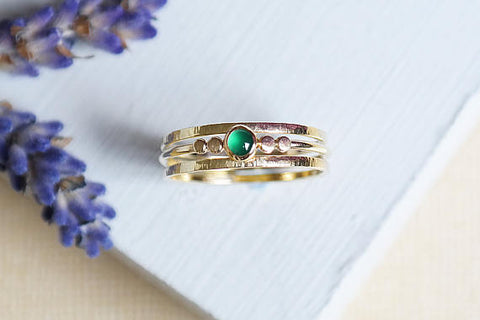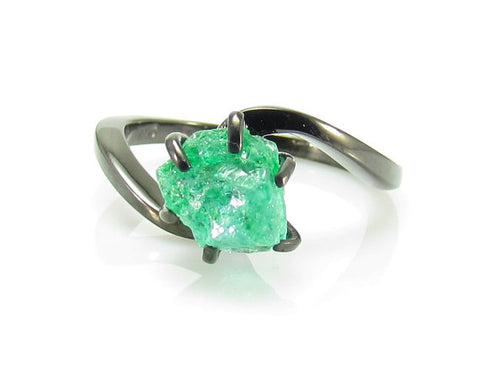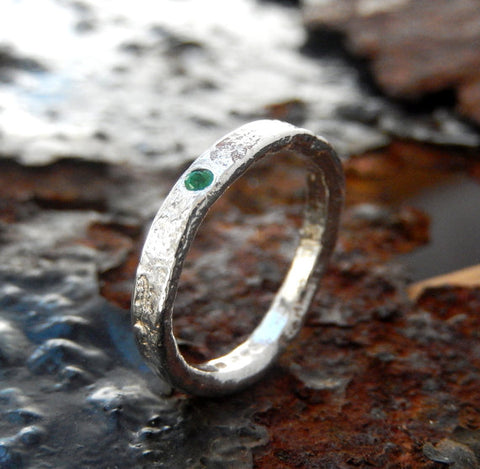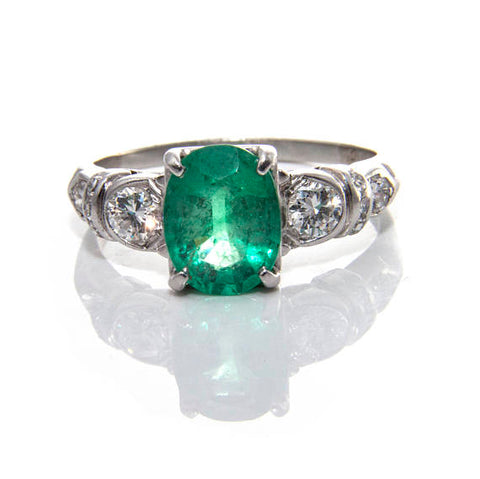If someone close to you was born in the month of May, then an emerald ring might just the perfect gift. Emerald is well known as the birthstone for anyone born in May. Not only does emerald represent May births, it’s also the gemstone used for the 20th, 35th and 55th wedding anniversaries. If you’re looking to buy a natural emerald ring be prepared to spend some money, natural emeralds are one of the most expensive gemstones available.
If your budget is limited, or if you’re not overly obsessed with buying a natural emerald, then it’s worth considering buying a synthetic emerald. There are many lab grown emeralds available in a huge range of hues, sizes and cuts, many of which are on a par with any naturally mined stones. If your goal is to buy a top quality affordable emerald ring then there’s no reason not to consider a synthetic stone if however, you’d rather buy a mined variety, then you’ll want to make sure you’re getting the absolute best deal possible. Emerald rings can be quite expensive so it’s with this in mind that we decided to write this article, we want to make sure you’re armed with all the necessary knowledge in order to make an informed decision. Read on and let us take you through the history, characteristics and features to look out for in this fascinating gemstone.

Emerald Ring History
The word emerald originated from the French word ‘esmeraude’, while in turn ‘esmeraude’ comes from the Greek and Latin word for greenstone ‘smaragdos’. Emeralds are ancient gemstones. According to the oldest surviving book in the world today, the ‘Papyrus Prisse’. “But good words are more difficult to find than the emerald, for it is by slaves that it is discovered among the rocks.".
The ‘Papyrus Prisse’ is over 4500 years old, but this particular passage is referencing another piece of writing from 1000 years earlier. It’s likely that the book is referring to the ancient Egyptian mines. Cleopatra’s mines were lost for thousands of years but were rediscovered in 1818. The poor quality and relatively small size of the stones produced by the mines was probably a factor in why they were originally abandoned.
It wasn’t just the Egyptians that prized emeralds, the Incas and Aztecs valued emeralds greatly when they were discovered in Columbia. Many cultures around the world have sought emeralds, attributing great value to the possession of these gems. Unfortunately, violence has been entwined with the history of emeralds, which is well illustrated by the fact that during the 16th century, Spanish inquisitors looted thousands of gems from mines in South America, murdering thousands of natives in the process. This even also put South America into the gemstone limelight. From this point forward, many wealthy individuals and royal families looked to South America to supply them with beautiful emerald stones to adorn their crowns, bracelets, necklaces and rings.
Regardless of whether the gem is the at the centre of a Russian crown, part of the Iranian state treasure, or is a favourite of a billionaire collector, emeralds have long been associated with status and royalty.
Choosing a Quality Emerald Ring
Making the decision to press the buy button when shopping for emerald rings online might not be a straightforward task, especially if you’re looking to ensure you’re buying a genuine emerald ring. There are a number of gemstone qualities which are worth understanding before committing to clicking the buy button. When selecting an emerald ring to buy it’s advisable to pay close attention to the emeralds shape, colour, size and clarity. Unlike diamonds which are graded using a specialist tool that allows for close inspection of the gemstone for any imperfections, emeralds are often graded using the naked eye. This makes your job as a buyer that much easier since you will have access to a range of product images that will allow you to review the gem with a critical eye. Before you can make an informed decision as to what constitutes a worthy buy it’s important to understand the critical characteristics of a high-quality emerald ring. Armed with this knowledge you should easily be able to get the best deal possible.
It should be noted, as with all coloured gemstones, the subtle differences that differentiate one high value gemstone from another are best left to the professionals. If in doubt seek expert advice before spending large amounts of money on an emerald ring.
Colour
The most sort after and desirable emerald colours are a bluish green through to a pure green, the colours must be vivid but the stone should not be overly dark. Stones which are highly transparent are intrinsically more valuable. The gem should have a uniformly even distribution of colour, with no obvious colour zoning. If the hue of the emerald is too blue or yellow, then stone is no longer classified as an emerald, but another type of beryl gemstone, and as such the value of the stone will decrease.
The colour intensity and saturation in an emerald is directly influenced by the trace elements chromium, valadium and iron. The presence and quantity of each of these elements determine the colour of the gem.
An emeralds visual qualities are sometimes closely associated with the mine it came from. For example, Columbian emeralds are said to produce an intense warm pure green colour. While Zambian emeralds are famous for producing stones which are cooler in colour, containing a noticeable blue hue.
Clarity
Most emeralds will contain inclusions that are visible to the naked eye. Due to this fact, it is widely accepted amongst jewellers and consumers that an emerald ring will likely contain an inclusion. A stone which is clean to the naked eye is very valuable as they are so rare.
Emeralds sometimes contain inclusions which appear mossy or garden-like. These flaws are often referred to as ‘jardin’, which is French for garden.
In all coloured stones, clarity and transparency are often closely linked. This is particularly true for emeralds. Professional jewellers will generally accept inclusions that are visible to the nakes eye, however, if those inclusions have effect on the transparency of the gemstone, then the value of emeralds is reduced.
Cut
It’s the cutters responsibility to consider carefully the rough gems depth of colour, durability and any inclusions before deciding on what cuts to make. A mistake may reduce the gems carat weight, which can significantly reduce the potential value of the emerald.
There are four important characteristics of emeralds which a cutter must take into account before beginning. Firstly, almost every stone has significant fractures. A cutter must, therefore, take those fractures into consideration to minimise the impact the fractures have on the finished stone.
The second factor to consider is the fact that emeralds are surprisingly brittle. This can make them vulnerable to damage while being cut, polished or set in a ring. A skilled cutter will design a gem in such a way as to minimise the potential for inadvertent damage to be caused to the stone.
Thirdly, due to the importance of colour in an emeralds value, the cuts must work to maximise the appearance of the saturation, tone and hue of the gem. The cutter can directly influence the colour by adjusting the emeralds proportions and number of facets. For example, a cutter can darken the appearance of a stone by creating deep cuts, a small table and creating few facets, or indeed lighten a stone with shallow cuts, a large table and additional facets.
Fourth, the bluish or greenish hues present in an emerald encourages the cutter to create the table so it lies perpendicular to the length of the crystal. This encourages the bluish-green hue to be more apparent in the finished gemstone.
Carat Weight
Cut and shaped emeralds come in a huge variety of sizes. There are of course huge emeralds in private collections and museums that weigh hundreds of carats. At the complete opposite end of scale are very small emeralds that weigh in at a fraction of a carat.
The Sandawana emerald mine located in Zimbabwe is famous for producing very small, but exquisitely coloured gemstones. The emeralds produced are often only 1mm square, but they are still incredibly beautiful with a stunning green hue. The mine’s stones average between 0.05 and 0.25 carats once cut, and very infrequently are in excess of 1.5 carats. Most jewellery is usually created from stones which are in between those carat weights.
As with most gemstones, as the size of the emerald increases, the cost will increase exponentially.
Emerald Ring Buying Tips
- Learn as much as you can about emeralds, this will help you to make an informed decision.
- Know that the finest gems originate from three Columbian mines: Muzo, Chivor and Cosquez. Be wary of anyone selling emeralds perpetrated to be from these locations at a cheap price.
- Examine the emerald for noticeable inclusions. Inclusions can serve to give the gemstone character and enhance the look of the gem, but they can also be used to help identify where it originated from. For example, a two-phase tubular inclusion is characteristic of a Chivor gemstone.
- It’s important to remember that all emeralds will typically contain inclusions, no matter the size. The process of forming an emerald dictates that inclusions will occur. Due to this, colour is far more important in an emerald, so don’t be afraid of buying a gemstone with brilliant colour which also includes inclusions.
- Make sure you know about the oiling process. Emeralds by nature are quite porous and will most often contain small air bubbles and fissures which are exposed when the gem is cut. In order to protect the emerald, a small amount of clear resin or oil is applied to the gem. This prevents contaminants such as hand lotions or detergents from seeping into the stone. As long as the oiling process is completed with a clear oil, it’s a standard practice, virtually all emeralds are treated in this way. However, if a green coloured oil is used in order to enhance the colour or to hide defects, then this needs to be clearly disclosed.
- Be wary of sales. Emeralds are exceedingly rare, so there is very little reason or incentive to discount the gemstone. Any heavily discounted stones should raise alarm bells.
- Don’t be overly concerned with the proportions of an emerald. As the gems are incredibly rare, they are generally cut in order to conserve as much of the original stone as possible. As such you might see some unusual shapes.
What is a Lab Grown Synthetic Emerald?
In short, a synthetic or lab created emerald will have all the exact same properties as natural emerald, the only difference will be where the gem originated from. A lab-grown emerald is 100% a real emerald, but it is not a natural emerald. It will possess all the same chemical, physical and optical properties as a natural emerald. However, synthetic emeralds are massively less expensive versus a similarly sized and graded natural stone.
A good natural emerald will cost a lot of money, a synthetic emerald much less so. If you’re not sure what to get, consider where your priority lies. Balance your desired weight, size and quality against how much you’re willing to spend.
Emerald Engagement / Wedding Rings
If you’re considering buying an emerald engagement or wedding ring, be absolutely certain that this is something that your fiancé would like. Even if your partner is not traditional in many aspects of her life, she might surprise you when it comes to her engagement ring. If you’re certain that it’s something that she would love, then you have a huge number of decisions to make. One of the first things you should consider is your budget, decide on how much you’d like to spend and stick to it. Consider if a natural or lab-grown emerald would suit your needs. Both types can be very beautiful, but a lab-grown emerald can allow you to buy a far larger stone for much less money, so it’s well worth considering.
source https://www.otomo.co.uk/blogs/news/14-exquisite-emerald-rings













No comments:
Post a Comment